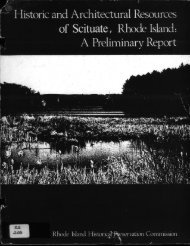National Park Service - Rhode Island Historical Preservation ...
National Park Service - Rhode Island Historical Preservation ...
National Park Service - Rhode Island Historical Preservation ...
You also want an ePaper? Increase the reach of your titles
YUMPU automatically turns print PDFs into web optimized ePapers that Google loves.
- ftBI8-y<br />
8. Significance<br />
Period Areas of Significance-check and justify below -<br />
prehistoric archeology-prehistoric X_ community planning X landscape architecture_ religion<br />
-- 1400-1499 archeology-historic conservation law - science<br />
1500-1599 agriculture economics literature sculpture<br />
- 1600-1699 & architecture education military 2_ social!<br />
-- 1700-1799 X. art X engineering music humanitarian<br />
_1 1800-1899 commerce exploration/settlement philosophy - theater<br />
& 1900- communications -X- industry -- politicsigovernment transportation<br />
invention - other specify<br />
Specific datesc1790-1937 Bu,lderArch.tect multiple, see inventory -<br />
Statement of Significance in one paragraph<br />
Peace Dale deserves recognition as a major example of an -.<br />
important New England phenomenon, the textile mill village.<br />
Developed during the nineteenth and early twentieth centuries,<br />
Peace Dale retains a high level of integrity. It is significant<br />
architecturally as an exemplar of its type containing<br />
characteristic industrial, residential, civic, and religious<br />
buildings, as well as a large number of noteworthy structures of<br />
all these varieties designed by architect Frank Angell and/or by<br />
mill owner and amateur architect Rowland Hazard II. It is also<br />
notable architecturally for a collection of stone-built<br />
structures illustrating the highly regarded craftsmanship of<br />
local masons. In the area of art, Peace Dale is significant as<br />
the site of a fine monument, "The Weaver", by Daniel Chester<br />
Frerch. In the area of landscape architecture, this is the<br />
setting for two handsome designs created by Charles Eliot, the<br />
"Water Way" and the grounds of the Hazard Memorial library and<br />
auditorium. In the field of community planning, Peace Dale’s<br />
studied informality and the special efforts the mill-owning<br />
Hazard family took to avoid the usual visual character of a<br />
company town bear note. The village has significance in the area<br />
of engineering due to its well preserved hydropower system and<br />
five stone-arch nineteenth-century bridges, all designed by<br />
Rowland Hazard II. -The industrial heritage of Peace Dale is<br />
considered important on several bases: the fabric of its factory<br />
complex is remarkably intact; the Peace Dale Manufacturing<br />
Company was an early, innovative, prize-winning producer of<br />
woolen goods; and- the mills and village were the creation of the<br />
Hazard family, who experimented here with a number of enlightened<br />
labor policies and attained prominence thereby in the annals of<br />
American industry. Finally, Peace Dale possesses significance in<br />
the "social/humanitarian" category, most particularly because its<br />
history and physical development so beautifully reflect the<br />
concept of benevolent paternalism which guided generations of<br />
Hazard family members as owners, leaders, and benefactors of the<br />
village. -<br />
Peace Dale is at once typical and unique: typical in that<br />
it is a rural industrial village, a common New England<br />
phenomenon; unique in its state of preservation, historic<br />
importance, and beauty. Peace Dale ranks with a handful of other<br />
communities as a truly outstanding example of this regional type.<br />
N















